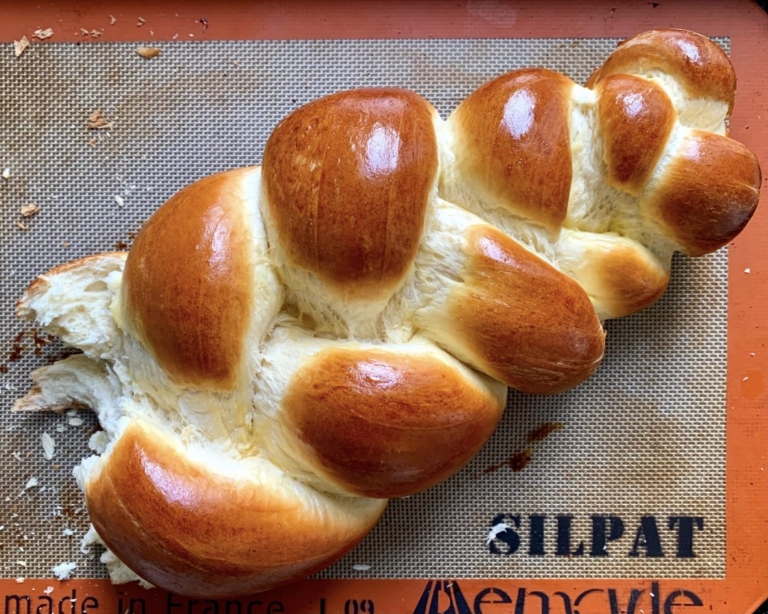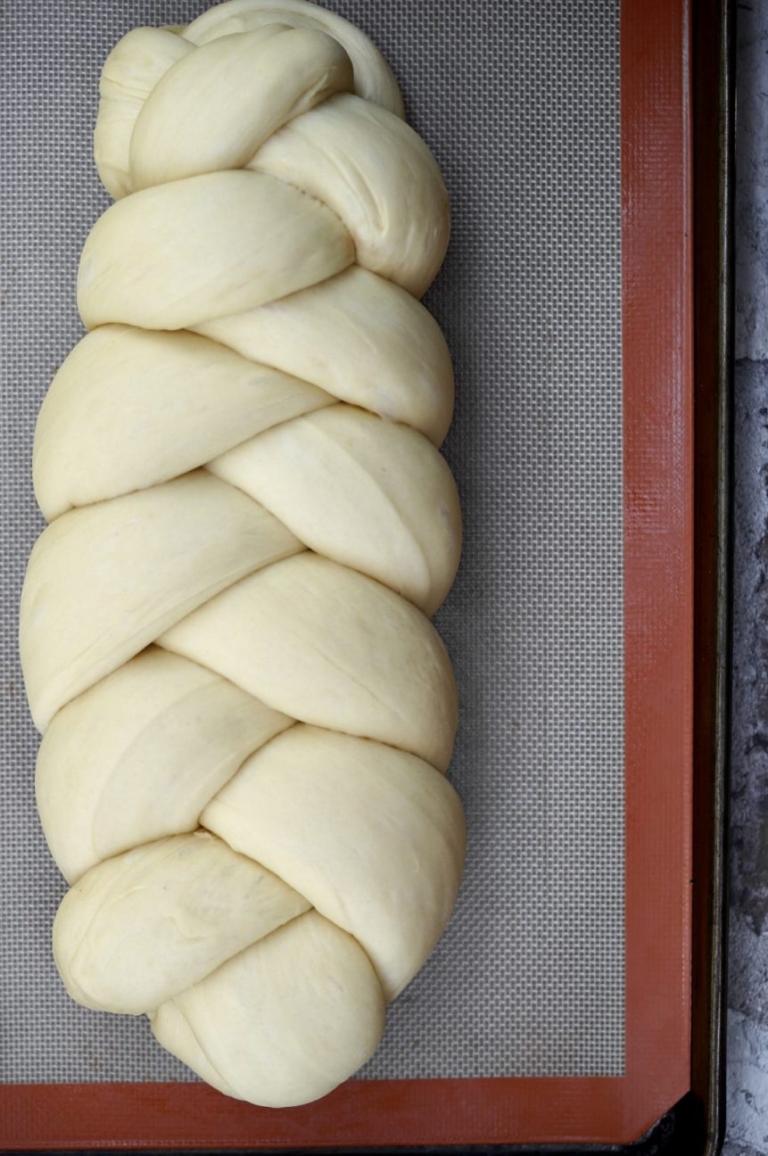Noah’s Favorite Challah Bread

Challah is a bread Jews consume on the Sabbath and holidays and it is surrounded by folklore, tradition, and symbolism. Braided challahs with three, four, or six strands are the most common. And because the braids look like arms intertwined, many people believe that they represent love.
Noah’s Bar Mitzvah
This is Noah’s favorite challah bread and one I now make weekly. This is not my recipe, the original is by Marcy Goldman, and it can be found in her cookbook, Jewish Holiday Baking. I have lightly adapted Goldman’s recipe over the years to fit our families’ tastes. This challah recipe has become especially meaningful for my younger son. I made this challah recipe for Noah’s bar mitzvah which was in December 2020. Like many special life events at the time, the severity of Covid meant we needed a new plan. The inability to gather in groups meant Noah’s bar mitzvah could not be held in person. Instead, we needed to hold it in our backyard, on Zoom, and (for the safety of everyone) without guests. At first, this was heartbreaking to accept. This was not the plan our son had worked so hard for. But Noah pushed ahead with grace and grit, despite the absence of family and friends and the intimidating presence of cameras, screens, mics, lights, and a full tech crew before him.
Something We All Need
In his speech, my son spoke about food and its significance in life, Judaism, and within our own family. He spoke about how food sustains us and connects us because we all need it. My son’s bar mitzvah was actually one of the first zoomitzvahas during pandemic life and something most were still unfamiliar with. To make the service feel a bit more special for those viewing, we sent small care packages to guests ahead of the big day. Inside the packages were some service essentials; a program, yarmulkas, candy to be tossed in the air in celebration when prompted once Noah completed his ceremonial duties, and a recipe for Noah’s favorite challah bread.
Feel the Love
What was so amazing, was on the actual day of Noah’s bar mitzvah, when I welcomed guests online before the service started, I looked up at a giant screen with all our guests, and saw many holding up beautiful, freshly baked challahs, made for the service, using the recipe we sent. I was blown away by this incredibly thoughtful gesture. The challahs, of all shapes and sizes, were incredible and connected all of us, even remotely.
Baking challah, or any bread for that matter, is a labor of love. Baking bread requires patience and flexibility that one obtains through repetition. But bread baking is also cathartic. Baking bread can provide a release of emotions, tensions, and stressors we all have within us, even if we don’t know it.
Noah nailed his zoomitzvaha and this challah bread, both plain or raisin, helped my whole family through the worst of the pandemic. It sounds silly I know, but it’s true. The challah helped calm our frayed nerves at the end of the week, it was truly restorative.
My Challah Tips
This particular recipe makes two very large challahs. Truthfully, when I make it, I typically split the recipe (which is not the easiest thing to do as halving an egg can be tricky), but trust me, it’s doable. I also adjust my flour amounts weekly based on the humidity that day, which one learns how to do with repetition. The main takeaway from this is that challah bread can be forgiving. The most important tip is to always use fresh yeast and activate it properly before you begin.
I hope you give Noah’s favorite challah recipe a try and if you do, please drop me a note and let me know if you enjoyed it. Because this is such a special recipe to me, I’d really love to hear your thoughts.
Noah's Favorite Challah Bread
Ingredients:
For the Sponge:
- 1 1/2 cups warm water
- 2 tablespoons dry active yeast
- pinch of sugar
- 2 cups bread flour
For the Dough:
- 1/2 cup warm water
- 3/4 cup sugar
- 3 teaspoons kosher salt
- 3 eggs, plus 1 egg yolk
- 1/2 cup vegetable oil
- 5-6 cups bread flour (as needed)
For the Egg Wash:
- 1 egg plus 1 egg yolk
Directions:
- For the Sponge: In a very large bowl, add the water, dry yeast, and pinch of sugar, mix well to blend, cover tightly with plastic wrap, and allow to rest for several minutes until the yeast swells and looks puffy. Mix again, add the flour, and stir until combined. Cover the bowl with plastic wrap again, place in a warm spot in the kitchen, and allow to rest for 1 hour.
- For the Dough: Stir down the sponge mixture in the work bowl and pour into a kitchen mixer, such as a kitchen Aid. Add the rest of the water, sugar, salt, eggs, egg yolk, oil, and about 5 1/2 cups of bread flour. Use your hands to mix until the dough is coming together but messy. Attach the bread hook attachment, cover the bowl with a damp kitchen cloth, and allow the dough to rest as is for 15-20 minutes to allow the dough to relax. After the rest period, turn the mixer on low and knead the dough with the dough hook until it's smooth and elastic, about 8-10 minutes adding an additional 1/4-1/2 cup flour as needed, to make the dough that is easy to handle and not too sticky or tacky.
- Shape the dough into a ball and place in a large lightly greased mixing bowl. Place the bowl in a large plastic ziplock or garbage bag and close it loosely. Let the dough rise in a draft-free, warm environment until almost doubled in size, anywhere from 45 minutes to 90 minutes depending on the warmth of your kitchen.
- Line two baking sheets with parchment paper and set near your workstation. Gently deflate the dough. If making two challahs, divide the dough in half for 2 loaves. Working with one at a time, divide into three equal pieces. Roll each of the three pieces into long event strands, about 12 inches in length. Gently pinch the top of the three strands together and braid the strands as you would a child's hair. Pinch the strands at the end. Tuck a small portion of each end slightly under the loaf and place it on the prepared backing sheet. Repeat this process with the remaining dough so you have two braided chilled loaves. Using a pastry brush, brush the loaves with the egg wash. Place both baking sheets in plastic bags. Or tent the challahs with plastic wrap and allow them to rise for 45 minutes to 90 minutes. (I find tenting to be easier than inserting the trays in large bags)
- Preheat the oven to 375 degrees F. Place the challah in the oven and reduce the heat to 350 degrees. Bake the challah, rotating once, until medium brown, about 30-35 minutes for two loaves. Bake for about 40 to 45 minutes for one large challah. Allow the challahs to cool before serving.



